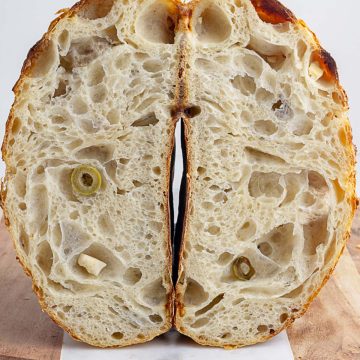
Feta and Olive Sourdough
This bold and flavorful feta sourdough bread with olives features briny olives, creamy feta cheese, a hint of sourness from the sourdough, all wrapped in a crusty sourdough loaf.
Ingredients
Dough:
- 350 g Bread Flour (about 2 ¾ cups)
- 70 g Sourdough Starter (about ¼ cup)
- 235 g Water (about 1 cup, reserve 15g)
- 7 g Salt (about 1 ¼ tsp)
Inclusions:
- 50 g Olives (roughly chopped about ¼ cup)
- 50 g Feta Cheese (crumbled about ¼ cup)
Instructions
Hydrate the Flour (Autolyse)
- In a large bowl, mix bread flour with most of the water (save some to mix with salt later).
- Use a dough whisk or the back of a ladle to combine until a rough, shaggy dough forms.
- Switch to wet hands to ensure all dry patches are moistened, scraping down the sides of the bowl as needed.
- Cover and rest for 45 minutes—this is the autolyse, which helps gluten begin developing naturally.
Add the Sourdough Starter
- Add your active sourdough starter to the hydrated dough.
- With wet hands, use the pinch-and-fold method to mix it in—pinching sections and folding them over repeatedly until the dough looks uniform and slightly elastic.
- Scrape down the bowl, cover, and rest for 30 minutes to jumpstart fermentation.
Add Salt and Reserved Water (Bassinage)
- Dissolve salt in the reserved water and pour it over the dough.
- Mix using wet hands, incorporating gently with a pinch-and-fold motion followed by soft kneading inside the bowl.
- As the dough tightens and becomes smoother, you'll feel it gain structure. Cover and let rest again for 20–30 minutes.
Bulk Fermentation with Stretch & Folds
- Let the dough ferment at room temperature (around 75°F).
- Over 4–6 hours, perform 4 sets of stretches and folds, spaced 30 minutes apart.
- Each fold strengthens the dough without aggressive kneading.
- Cover between sets and let the dough rise slowly.
Lamination: Add Olives & Feta
- After bulk fermentation, turn the dough onto a lightly floured surface. Gently stretch it into a large, thin rectangle.
- Evenly scatter chopped olives and crumbled feta over the surface.
- Fold the dough like a letter, then rotate and fold once more (book fold) to lock inclusions inside.
- Rest the dough uncovered for 10–15 minutes.
Shape the Batard
- Lightly flour your surface. Flip the dough so the smooth side faces down.
- Pat gently into a rectangle, fold the long edges inward slightly overlapping, then roll it from the top down into a tight batard.
- Pinch the seam and sides to seal and build surface tension.
Cold Proof
- Place the shaped dough seam-side up into a well-floured banneton or lined bowl. Cover and refrigerate for 8–12 hours. This cold proofing (retardation) helps build flavor and structure.
Bake
- Preheat a Dutch oven at 500°F (260°C).
- Turn the dough out onto parchment paper, score the top, and transfer to the hot Dutch oven.
- Bake covered for 20 minutes.
- Then bake uncovered at 450°F (230°C) for another 20–22 minutes.
- Let the bread cool on a wire rack for at least 1 hour before slicing.
Notes
- Use a mature, active sourdough starter
For the best rise and flavor, your sourdough starter should be bubbly, airy, and pass the float test. If your starter isn't ready, your olive and feta sourdough recipe may turn out dense or under-proofed. - Always measure using a kitchen scale
Sourdough baking is sensitive to hydration levels. Use a digital kitchen scale for precise results, especially when working with additions like feta cheese, olives, or sun-dried tomatoes. - Room temperature ingredients are key
Ensure your water, sourdough starter, and flour are all at room temperature. Cold ingredients can slow down fermentation, while overly warm ingredients may accelerate it too fast. - Lamination helps ensure even inclusion distribution
Instead of mixing in feta and olives directly, laminate the dough after bulk fermentation. This gentle technique helps you spread inclusions without degassing the dough, ensuring even flavor and a beautiful open crumb. - Prevent sticking with parchment paper and rice flour
Always use parchment paper when baking in a Dutch oven, and dust your banneton with a mix of bread and rice flour to prevent the dough from sticking during cold proof. - Customize your inclusions
Try swapping feta with goat cheese or aged cheddar. You can also add finely chopped sun-dried tomatoes, roasted garlic, caramelized onions, or herbs like dill to create variations like onion dill sourdough bread or cheddar dill sourdough bread. - Olive types make a difference
Use pitted Kalamata or green olives for the best results. Roughly chop for even distribution. - Avoid overhandling after adding feta
Feta is a delicate cheese. Overmixing can crush it and make your dough overly wet or uneven. Gently fold it in during lamination for the best texture.
Nutrition
Calories: 138kcalCarbohydrates: 24.51gProtein: 4.76gFat: 2.15gSodium: 365mgFiber: 1gSugar: 0.55gVitamin A: 35IUCalcium: 32mg
Tried this recipe?Let us know how it was!